A media pitch is an attempt to get a journalist or editor interested in your news so that they decide to cover it, resulting in media coverage.
Almost always, a media pitch is done by email, but it’s also possible to do it via social platforms, telephone, or traditional mail.
Although pitching journalists is similar to sending a press release, the key difference is that a media pitch does not have to include one.
In this post, you'll learn how to write an effective media pitch and find 7 practical examples from PR professionals.
If you're looking to send a PR pitch, you can try Prowly's free 7-day trial. Find relevant journalists, gain access to useful templates, and send personalized pitches at scale—all from one tool.
Before you write a media pitch
Before you begin: Journalists and editors are flooded with press releases, media pitches, and various other demands on their time and attention.
Based on research from Fractl, 46.5% of journalists receive at least 11 media pitches per day, while 28.64% receive over 26 pitches per day.
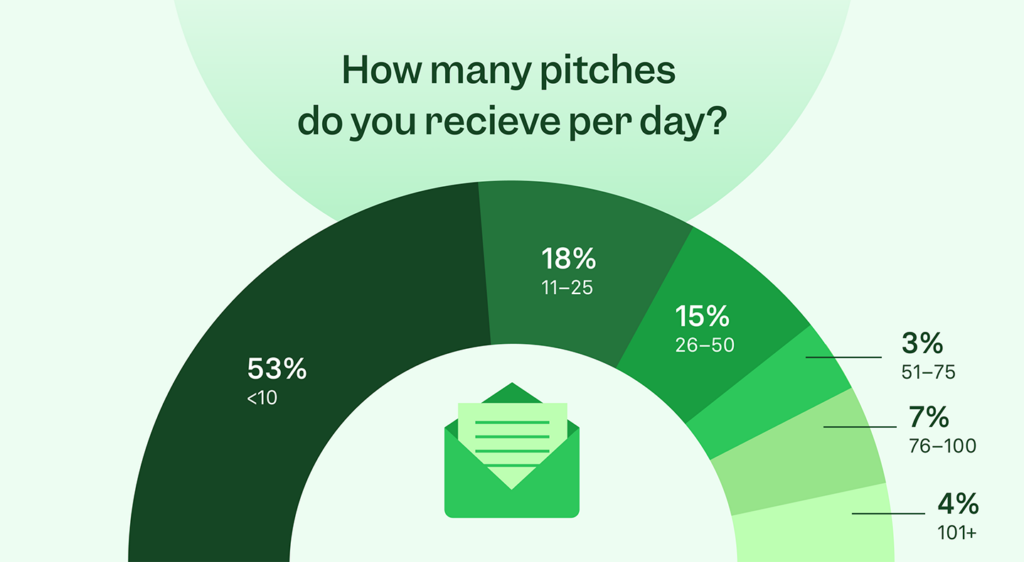
Knowing what to include in your media pitch—and what to leave out—will greatly improve your chances of getting a reply. Keep in mind, even a single typo in a cold pitch is enough to turn possibility into disaster.
How to write a media pitch
If you've written any type of email pitch before, you'll quickly realize that writing a media pitch is similar. There are, however, a few key differences that you have to keep in mind.
We've broken down writing a PR pitch into 7, easy-to-follow steps:
1. Make sure your story is newsworthy
It’s all in the subject line. If you want to get someone to cover your story, it’s worth asking yourself these two questions before you even think about pitching the media outlet:
- Is my news actually newsworthy?
- Is my news presented in an exciting way that will get people interested?
The best pitch emails answer these questions with a resounding, “yes!” If not, it might be worth waiting until you have something that is actually newsworthy.
Also, when crafting a press release that you might send in a pitch, it is vital to take into account your target audience and the preferences of journalists from the outset.
For example, outstanding book press releases give readers an enticing glimpse of what lies ahead, avoiding spoilers, while sports journalists need short, "twittable" quotes and a set of statements from athletes.
Otherwise, you could make a bad first impression with the media contacts you send your press release to.
What makes a newsworthy story? According to socialmediasydney.net.au, you should consider the following:
- Is the story new and current?
- Does it feature an element of prominence?
- Does it evoke an emotional response?
- Will your story affect or have an impact on certain people?
- Is your story relevant to the area/publication you are pitching it to?
Amber Mac, entrepreneur, and bestselling author sums this up perfectly:
The fact that your company exists or your CEO will be in town does not make a story.
2. Make sure you're pitching relevant media contacts
Before writing your media pitch, you should first find relevant media contacts to prepare a media list, which is a list of people who could be interested in covering your story. In addition to journalists, this could include social media personalities on Linkedin, influencers, bloggers, podcast hosts, and even other PR Professionals.
In the media, individual journalists have their own specializations (referred to as a "beat"). Instead of sending your pitch to the general email address of a news outlet, it is best to address it to the person most relevant to the subject you’re writing about. In other words: make sure you're knocking on the right doors before you start knocking.
If you're using a tool like Prowly, you can identify relevant journalists by searching through the media database and using filters such as keywords in recent articles, industry, or location.
Prowly enhances contact searches with unique features:
👉🏼 Partnership with Semrush provides exclusive data on audience and traffic.
👉🏼 AI keyword suggestions expand search possibilities, opening new coverage opportunities and targeting niche topics.
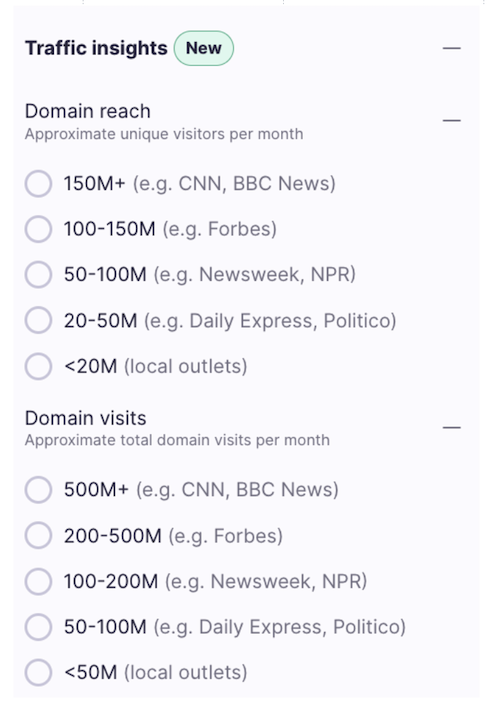
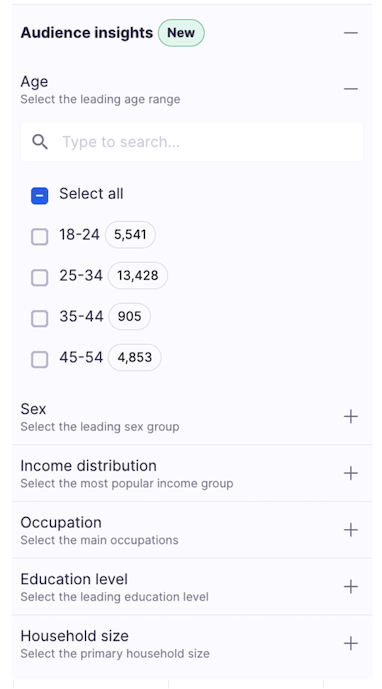
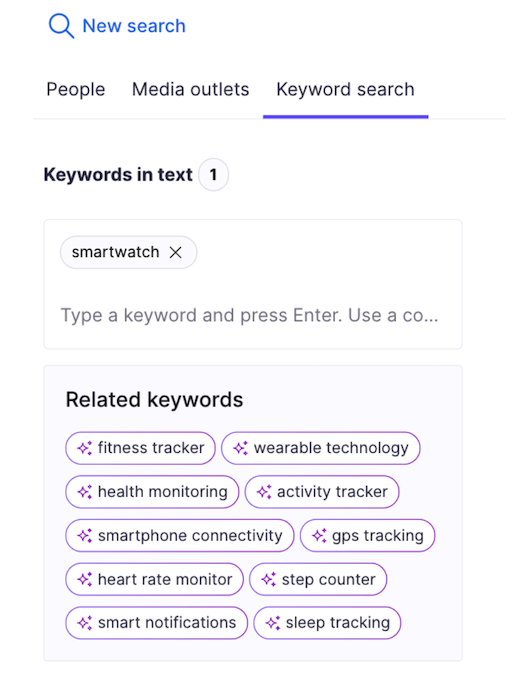
Now you can also go to the keyword search tab to discover new keywords that could be interesting for journalists thanks to AI suggesting:
- Go to the “Keyword search” tab and follow AI suggestions - start with your main keyword (product category): “smartwatch” and then follow AI suggestions for related keywords and choose those that fit to your story angle (fitness or health) or be inspired with keyword ideas to give a twist to your pitch.
- Narrow down your search - check articles or tweets, or both; only from last week or last month, only from online media outlets from the USA or only those posted on blogs.
- Check the publishing frequency - how many times a particular journalist published an article containing your keyword.
It’s like having a brainstorming buddy, coming up with pitching angles and journalists who might be interested in this topic.
👉🏼 Result? A short list of contacts to journalists to have been recently writing about a very particular topic, with easily accessible recent articles in the results to quickly scan them.
Make it easier to find journalists and build relationships with highly targeted contacts — learn everything about using Audience Analytics and AI Keyword research from this article.
Example: If you're a small business or startup that's launching a new product and you're reaching out to a magazine like WIRED, Forbes, or the New York Times, you'll find out that every reporter there has their own specialization, such as drones, cell phones, or cloud computing. In this case, the right thing to do would be to reach out to the person that writes about products like yours, instead of pitching to someone that generally covers technology.
3. Write your subject line
When writing a media pitch subject line you want to keep in mind that this is your big first impression, this is the first thing your selected journalists will see and you want it to make a mark and get your email opened.
So remember these simple rules:
Keep things clear
Simply put, be sure to say it is a pitch. You don’t want to hide your email behind flowery language and get your pitch lost in a journalist’s already overflowing inbox. So put the name right on the label to keep your intent clear and your pitch easy to find.
Keep things short
You might be tempted to dress up the subject line with extra buzzwords and enhancing language. I mean what’s even better than a new product? An exciting new product, of course! But the subject line is simply not the place for it. A good guideline to keep in mind is you want to keep your subject line under 49 characters, total. Doing so is proven to boost your open rates and more.
Here are a few quick media pitch subject line examples:
- Pitch: Interview: Therapist and Entrepreneur on How to Manage Everyday Stress
- Pitch: 83% of cold pitches are irrelevant and ignored, journalists say
- Pitch: Why You Need To Stop Wearing Your Cell Phone In Your Pocket
💡 For a more detailed guide, here’s everything you need to know about writing an exceptional pitch subject line.
4. Grab their attention early on
Let’s start at the very beginning, the address line.
You want to address your pitch as precisely as you can, ideally with your journalist’s name and professional titles. If you’re using a media contact database this information should be in easy reach. “To whom it may concern,” may have floated you once or twice, but it’s a poor beginning to establishing meaningful relationships with your chosen journalists. That personal touch can work wonders.
This is also a good moment to double-check your chosen journalist's beat, or their field of expertise, to be absolutely sure you’re pitching to the right person. Once you have that checked off the list, what next?
Get straight to the point
Your journalist is going to want to know the big W’s: Who, What, When, Where, and Why?
So it’s best to put these right up front. These should make up the content of your opening paragraph so the journalist can be sure that your news covers their and your audiences’ interests. This is best encapsulated in a compelling lead that includes your trending topic and your timeframe. Remember, there’s no news like fresh news.
Offer an appealing angle
By providing journalists with different options for how to cover a story, you increase the chances that they will find an angle that fits their publication's style and target audience, and thus you’ll be more likely to gain press coverage.
Aleksandra Kubicka, PR consultant at Prowly, recommends:
To create an effective media pitch, PR managers can transform news into a few different stories and can present it from different angles. This will help to reach a larger target audience. To achieve it we need to be creative and look for unique perspectives of each story.
For example, instead of just presenting a story about a new business as straightforward news, you could also focus on the human story behind the business, such as the background and motivations of its founder. Another angle could be to highlight the success of a local business in gaining recognition in the global market, which would appeal to local media outlets.
5. Write an email that connects
You want to write content that the journalist can see will resonate with their readers. You want to make sure that you and the journalist are on the same page, and that the journalist has ready angles that they can use to frame your story to their readers.
Trust us when we say that journalists love it when PRs do some of their work for them.
But there are a few things that you can do to make sure your news really stands out amongst media pitches:
Give them expert sources
What did we say about doing the journalist's work for them? Your chosen journalist may well have their own expert sources in mind, but the more the merrier! You may even find a few that are truly unique to your article, such as academic experts or a CEO, that can grant your story extra strength.
Send them relevant links
Generally speaking, you don’t want to bog down your pitch with excessive graphs and data, but you can still include these with carefully chosen external links related to your news. This can increase reader engagement and enhance your credibility, both with your journalist and their audience.
Tell them what you’re offering
You’ve already gone through the trouble of hand-picking what journalist and news outlet to pitch, so why not share why you chose them? Mentioning your criteria and why you chose to pitch them exclusively can help personalize your pitch and reinforce your relationship.
6. Make your call to action
A carefully crafted call to action is an absolute must. Ideally, you want to express why this story matters, how it is relevant to your journalist’s readers, and reinforce your timing. This is your moment to keep things focused on your audience, your journalist, and their readers.
7. Conclude your media pitch
Your conclusion should be a boiled-down summary of your pitch but presented in reverse. You can begin by restating your call to action in a fresh and unique way, adding any last relevant data or links that the journalist might find useful, and finally thanking your media contact for their valuable time. Remember to use a unique and polite sign-off and, finally…
End on your boilerplate
You know what this is. In the end, you want an easy and accessible summary of all your essentials. Your contact details, your background, why you’re the perfect person to pitch this news, and any professional achievements relevant to your pitch and your news.
Using AI to write media pitches
With the recent advance of AI, creating content has become easier than ever, and media pitching is no exception.
Many PR tools now include AI as part of their features which can help with the whole PR outreach process—from finding relevant journalists to writing effective media pitches.
Using a tool like Prowly, you're able to instantly generate a media pitch email based on the contents of your press release.
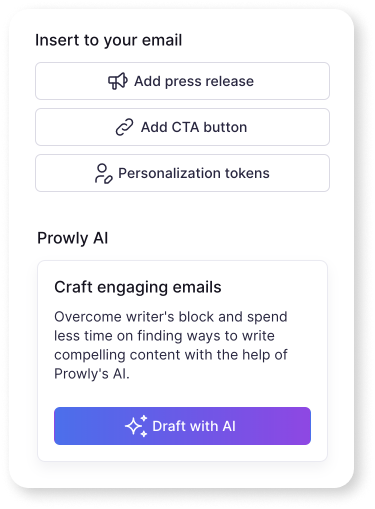
And if you're looking for journalists to cover your AI-related story, check out this list.
7 media pitch examples from PR experts
Below you will find the best PR pitch examples shared by actual PR experts demonstrating just how to write a pitch to a journalist. Some information has been blanked out for privacy reasons surrounding previous works.
The following media pitch letter examples were re-created in Prowly, where you can find relevant media contacts and effectively send email pitches with personalization and analytics to help promote your PR strategy.
Media pitch example #1
Rudi Davis, Chief Operating Officer @ NetPositiveAgency
The first media pitch example is from Rudi, COO of NetPositiveAgency.
Rudi leverages the expertise of his client and offers expert insights on the topic that the reporter covers.
Instead of proposing just one topic, Rudi gives the pitch recipient to choose from three in-depth topics, increasing the chance of success.
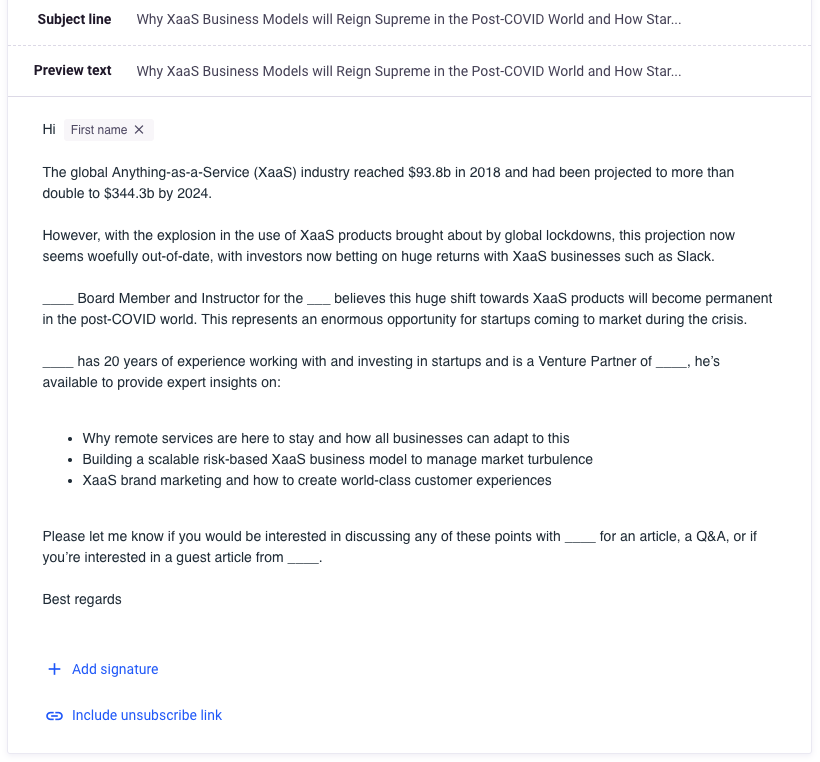
Email pitch example #2
Mary Brynn Millburn, Senior Public Relations Coordinator @ Idea Grove
This news story pitch example from Mary Brynn Millburn shows the importance of a good value proposition. Take note of how the reporter is offered expert commentary and fresh information from the CEO of the company hoping to get coverage.

PR pitch example #3
Sarah Jenne, PR Specialist @ Idea Grove
In Sarah's PR pitch email example, she takes advantage of the fact that she's previously connected with this specific reporter, reminding him/her of their already established relationship.
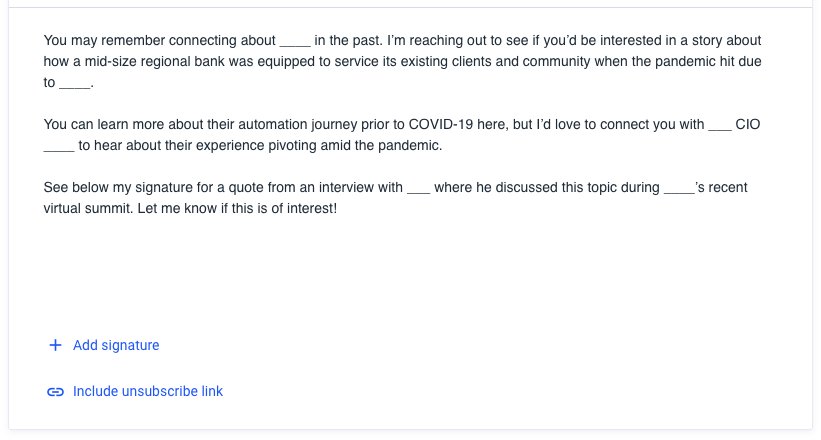
Media pitch example #4
Ana Casic, responsible for media relations and PR @ TalentLMS
Ana Casic from TalentLMS send us this press release pitch email example on remote work. She started the conversation by mentioning already published articles on the same topic, and offered new & original research (offering value!) that could be used for a new post.
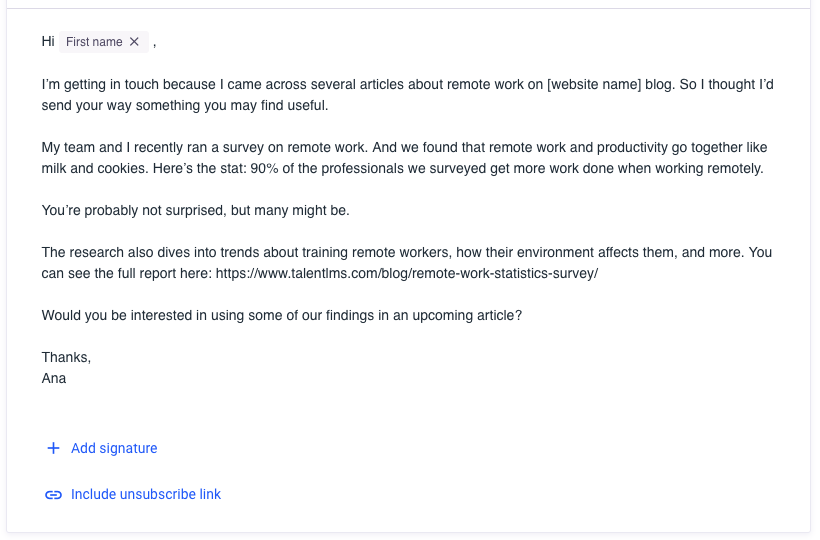
PR pitch example #5
Matthew Zajechowski, Outreach Team Lead and Content Marketing Promotions Specialist @ Digital Third Coast Internet Marketing
Similar to the previous example, Matthew's media pitching is another example of giving value by offering an original report on a topic that was newsworthy at the time.
The results? Over 250+ unique placements all who’ve linked back to this page for this campaign using this specific pitch.
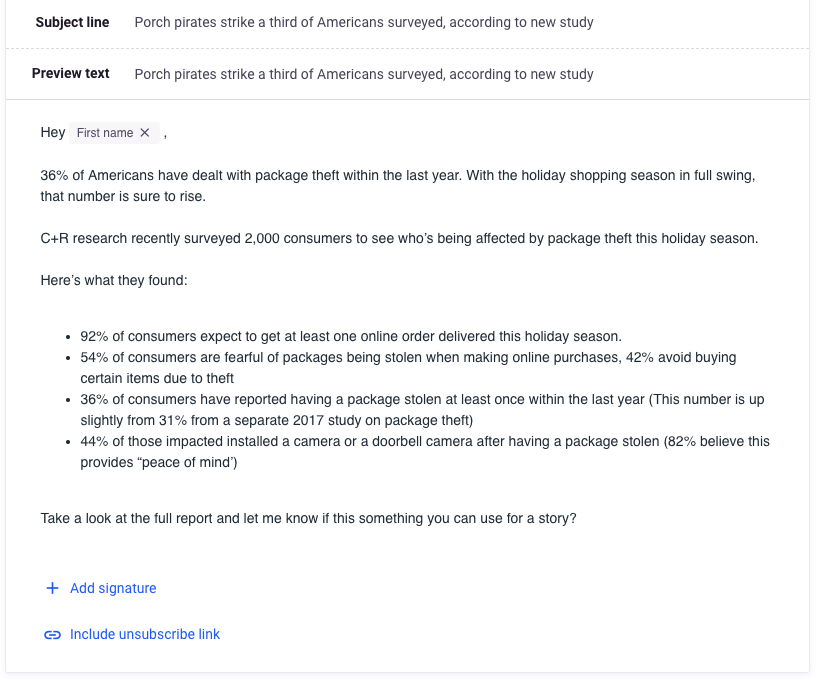
Email pitch example #6
Corinne McCarthy, SEO & Online PR Specialist @ Web Talent Marketing
Here is a media pitch letter example that earned a placement on CNBC’s website (cnbc.com) for a client of Web Talent Marketing.
The writer we pitched ended up connecting us with a reporter at CNBC. The reporter interviewed our client’s Content Manager. A few weeks later, CNBC published a feature article about the career path we pitched and quoted our client throughout the article.
Corinne added that the key elements of this pitch are:
- Addresses the writer by name twice so he/she knows this is not an automated email.
- Mentions a recent article that relates to the topic you’re pitching.
- Includes a brief description of the angle you’re pitching and why it’s relevant to the publication.
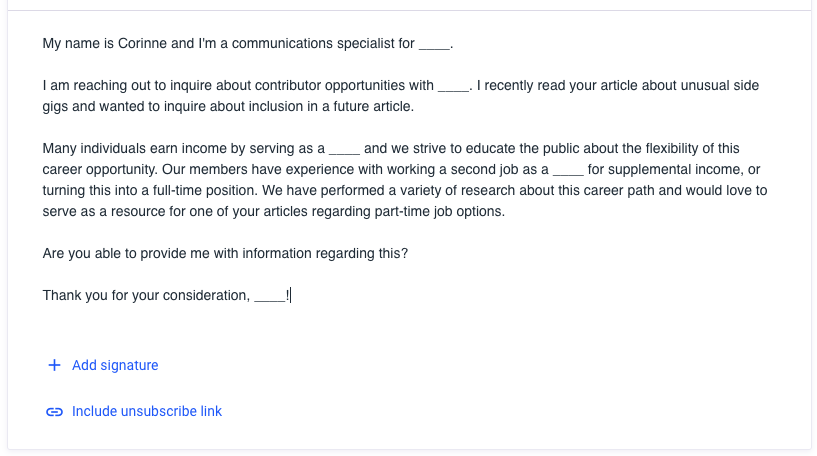
Media pitch example #7
Rachel Nelson, Public Relations & Events Manager at Margaux Agency
The last media pitch example from Rachel Nelson offers value by offering valuable content that could be useful for a new article that's not only original but also exclusive.
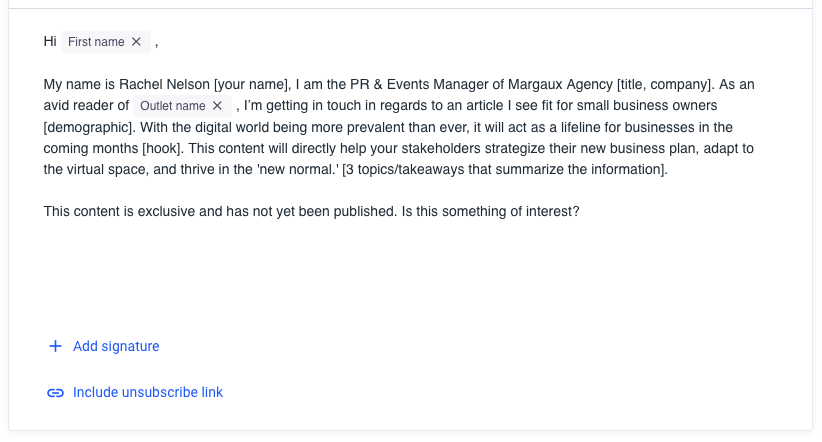
You can gain access to Prowly’s own media pitch templates for more guidance and inspiration from story pitch examples for journalism down to email subject lines.
How to follow up on your media pitch effectively
Even if you did everything correctly, there's a chance you won't get a reply. It makes you start wondering:
- Did the journalist get my email?
- Did it get opened or was it lost in the sea of other media pitches?
- Was my pitch so bad that it got posted online for everyone to laugh at?
Just kidding. Journalists are busy people; it could be that they were simply busy and didn't get to check their inbox yet.
Whatever the reason, it doesn't mean you should move on just yet.
As a general rule, you shouldn't email someone more than three times in a row without success. If you subtract the first email, that leaves you with two follow-up attempts for your pitch. Give at least a few days between each email. The same applies to calls, so if you have your journalist’s phone number, it’s important to keep them within this rule of three.
If you're using a PR outreach tool like Prowly to pitch media contacts, you can view which recipients received, opened, and clicked on your email. This lets you easily segment your follow-up message in to groups and tailor your message based on if they've opened your email—or not.
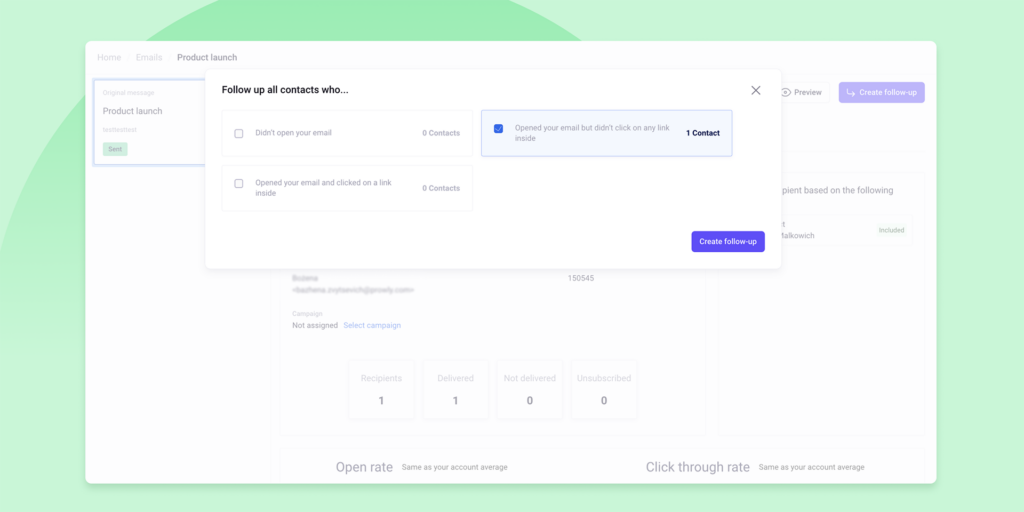
When you do follow up, keep in mind the following:
- Be polite. Respect the fact that a journalist may not be interested in your story
- Be concise and to the point. Keeping the above point in mind, politely re-ask if they're interested or if you can provide any extra details
- Be prepared. If you do get a positive reply make sure you have any extra information they might need or a flexible schedule if they'd like to interview you for more details
Read more: Following up on Your Media Pitch – How to Do It Right
Conclusion
A media pitch can be crafted in many different ways, with PR experts often having their own preferred method. Nonetheless, the fundamentals of writing a successful pitch remain the same, whether it be how to write a pitch letter for an event or product launch.
Follow the tips and examples in this post and tailor them to your news. With a bit of time and experimentation, you'll find what works and what doesn't. Refining your pitching strategy is the first step to getting publications, which lead to backlinks and enhances your overall media coverage.

